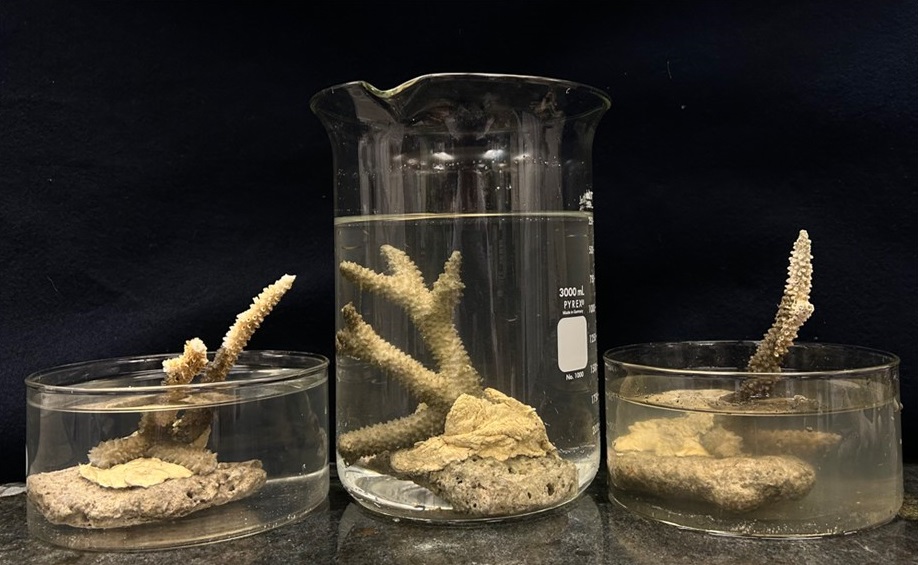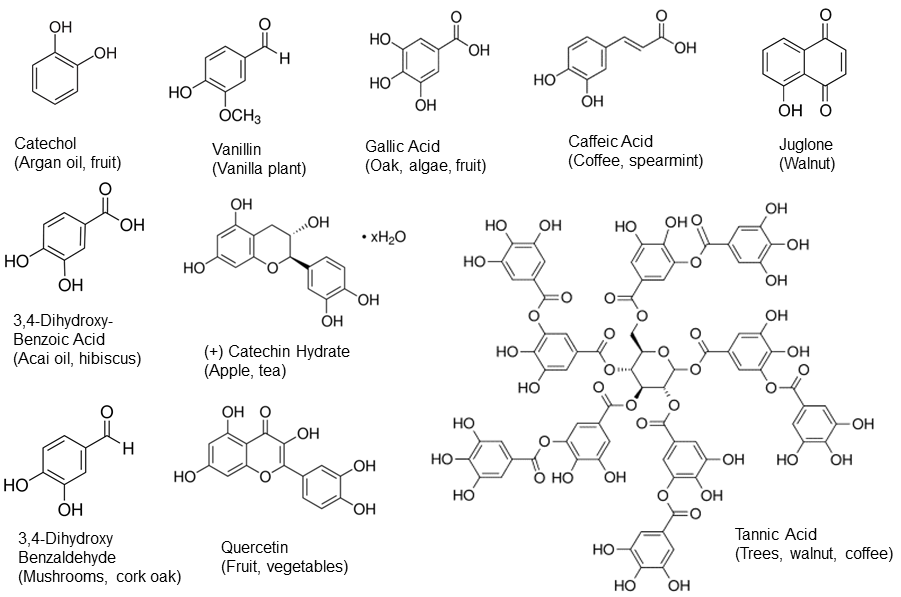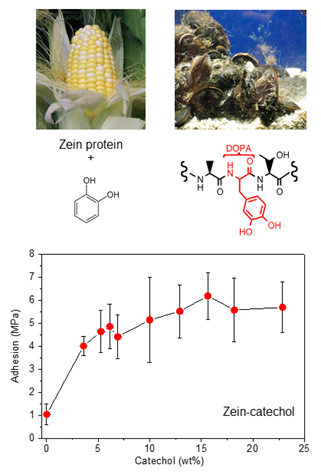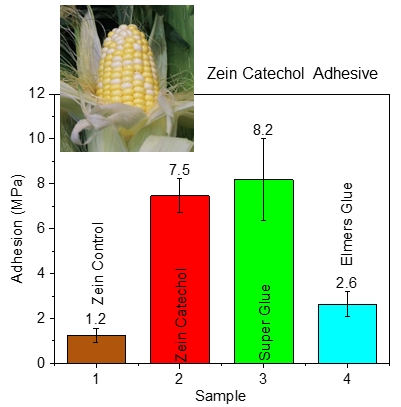Research
We have expertise in polymer and materials chemistry with a focus on developing structure-property relationships. This includes the design, synthesis and characterization of polymeric materials on the nanometer to the micrometer length scales. We are currently exploring how to make adhesives from plant - based protein and phenolic components.
1) Plant-Based Underwater Adhesives Developed for Bonding Coral in Sea Water (collaborative project)
Many commercial adhesives are derived from petroleum, cannot degrade, and are unable to
bond in wet environments. Adhesive materials are needed for applications ranging from bonding biomedical
devices to repairing coral reefs. With changing ocean chemistry, corals are bleaching. Efforts to plant heat- and
acid-tolerant species are hampered by the lack of viable underwater glues. We are working toward making biobased adhesives that create strong bonds underwater. The base system is made from zein, a protein from corn, cross-linked with tannic acid. Inorganic materials were added to generate the particularly strong underwater adhesives. Structure−function studies showed that inorganic components such as layered silicate and calcium carbonate increased the bond strengths significantly. Viscosity studies demonstrated shear thinning properties that are critical for adhesive applications. Adhesion was measured on time frames as short as 10 min and as long as 9 weeks. These materials were then used for the attachment of coral skeletons to substrates. The resulting underwater adhesives can be made on large scales, are easy to handle, bond strongly, and may provide a path to enabling more widespread planting of corals.
Related Publication:
G. Schmidt*, L. H. Kitts, R. V. Fisher, N. Supasueb, J. J. Wilker “Plant-Based Underwater Adhesives Developed for Bonding Coral in Sea Water”, ACS Applied Polymer materials, 2025, https://doi.org/10.1021/acsapm.5c01029

Figure 1. Coral skeletons glued to coral substrates in artificial sea water.
2) Underwater Bonding with Plant-Based Adhesives (collaborative project)
We are working on several adhesive formulations made from corn zein protein and tannic acid that can bind to a wide range of surfaces underwater. Higher performance comes from more tannic acid than zein, whereas dry bonding required the opposite case of more zein than tannic acid. Each adhesive works best in the environment that it was designed and optimized for. We show underwater adhesion experiments done on different substrates and in different waters. Surprisingly, the water salinity does not influence the performance to a great deal but the substrate type does. An additional unexpected result was bond strength increasing over time when exposed to water, contradicting general experiments of working with glues. The shape of the adhesive could be manipulated easily and, once in place, the skin formed around the adhesive underwater could be broken to induce faster bond formation. Data indicated that underwater adhesion was predominantly induced by tannic acid, cross-linking within the bulk for adhesion and to the substrate surfaces. The zein protein provided a less polar matrix that helped to keep the tannic acid molecules in place. These studies provide new plant-based adhesives for working underwater and for creating a more sustainable environment.
Related Publication:
G. Schmidt*, P. Christ, P. Kertes, R. Fisher, L. Miles , J. J. Wilker “Underwater Bonding with a Bio-based Adhesive from Tannic Acid and Zein Protein”, ACS Applied Materials & Interfaces, 2023, https://doi.org/10.1021/acsami.3c04009

Figure 1. Performance of zein−tannic acid over time. An optimized formulation of zein −tannic acid was used. Water types with increased salinity were evaluated at room temperature.
3) Zein - Tannic Acid Adhesives for Dry Bonding Different Substrates (collaborative project)
Plant-based, nontoxic and strong adhesives that can work on different substrates allow for better product recycling. Replacing synthetic adhesives with plant based ones that perform equally well may lead to a more sustainable ecosystem. Adhesives based on zein protein, derived from corn, can be made as strong as Super Glue. Unlike petroleum-based adhesives, this plant protein is removable and degradable. Adhesives from the
components zein and tannic acid function well on different substrates such as metals, plastics, and wood. To achieve near Super Glue strength, each substrate requires a different adhesive formulation. Temperature-dependent curing and other variables influence adhesion. Tack testing at room temperature is measured to provide comparisons between initial bonding and that achieved after curing. Adhesion to plastic substrates is less than wood or metal, but still plenty strong to measure. Aging of adhesive solutions as well as water resistance after curing is investigated. Infrared spectroscopy data can be correlated with changes in color, age, and pH
of adhesives. These new adhesives may lead to a sustainable and cleaner environment.
Related Publication:
G. Schmidt* , K. Smith, L. Miles, C. Gettelfinger, J. Hawthorne , E. Fruzyna , J. J. Wilker “Tunable Tannic Acid – Zein Adhesives for Bonding Different Substrates”, Adv. Sustainable Syst., 2022, 2100392 https://doi.org/10.1002/adsu.202100392

Figure 1. a) Adhesive strength of a zein - tannic acid formulation from lap-shear testing as function of adhesive solution age prior to use. Inset: The pH of the adhesive solution changes over time, see dashed arrow. Samples that yielded data in (a) have been cured at 120 °C for 24 h. b) One day old and 20 day old adhesive solutions spread and dried on glass slides showed color changes upon storage. Also shown are viscosity changes over time in adhesive solutions 47 days old and after day 60. c) Wood adherend pair showing the wood broke before the glue failed for lap-shear experiments done with fresh adhesive on day 1.

Figure 2. Naturally occurring phenolic compounds containing catechol-like molecules. Advanced Sustainable Syst., 2018, 2 (3), 1700159
 Figure 3. Corn zein protein can be cross-linked with plant phenolics to mimic the adhesion chemistry of marine mussels. Top left: Images of catechol molecule and corn used for extracting zein protein. Top right: Mussels attaching to a glass surface. The DOPA amino acid (red) is key for the cross-linking and adhesion of mussel proteins. Bottom: Adhesion of zein-catechol as function of catechol concentration (in weight %).
Figure 3. Corn zein protein can be cross-linked with plant phenolics to mimic the adhesion chemistry of marine mussels. Top left: Images of catechol molecule and corn used for extracting zein protein. Top right: Mussels attaching to a glass surface. The DOPA amino acid (red) is key for the cross-linking and adhesion of mussel proteins. Bottom: Adhesion of zein-catechol as function of catechol concentration (in weight %).
Advanced Sustainable Syst., 2018, 2 (3), 1700159
 Figure 4. When combined properly, corn zein protein and plant phenolics can generate high strength adhesives. Bonding competes well with common commercial products, adhesion of wet substrates is quite substantial and resistance to water is significant. Advanced Sustainable Syst., 2018, 2 (3), 1700159
Figure 4. When combined properly, corn zein protein and plant phenolics can generate high strength adhesives. Bonding competes well with common commercial products, adhesion of wet substrates is quite substantial and resistance to water is significant. Advanced Sustainable Syst., 2018, 2 (3), 1700159